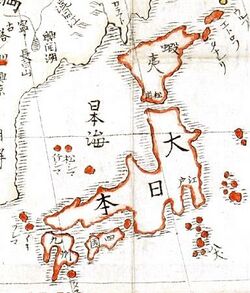فترة جومون
| جزء من سلسلة عن |
| تاريخ اليابان |
|---|
 |
فترة جومون (باليابانية: 縄文時代) بين سنوات (8000 ق.م. حتى 300 ق.م.): من الفترات القديمة للتاريخ الياباني. أهم ما ميز هذه الفترة ظهور صناعة الخزف والطريقة الفريدة في زخرفتها.
انتهى العصر الحجري القديم ح 8000 ق.م. ليترك مكانه للعصر الحجري الوسيط، الذي يسميه المؤرخون اليابانيون فترة "جومون"، والذي تميز بتطور مجتمعات بدائية على كامل الأرخبيل قامت على نشاطي الصيد والجني – قبل ظهور الزراعة-.
عثر على أواني خزفية للفترة نفسها أثناء حفريات مختلفة، ووجدت عليها آثار لزخارف تم إنجازها عن طريق حبال مختلفة، مما حدا بالمؤرخين لأن يطلقوا على هذا الفترة اسم "فترة الخزف ذو الزخارف الحبلية"، و كانت هذه الخزفيات الأولى من نوعها، حيث لم يكن ممكنا قبل هذا العهد التحكم في شكلها النهائي. كانت هذه الأعمال من العلامات الأولى على ظهور ثقافة بدائية يابانية.

مع بدء مرحلة الاستقرار وانتهاء حياة الترحال، ظهرت الزراعة. دخلت تقنية زراعة الأرز في الحقول المغمورة بالمياه والتي استحدثها الصينيون إلى اليابان عن طريق كورية. يرجح أنها انتشرت منذ القرن الخامس ق.م.
يقسم المؤرخون هذه الفترة إلى عصور مختلفة:
- جومون الوليد : 10,000 ق.م حتى 8,000 ق.م
- جومون البدائي : 8,000 ق.م حتى 5,000 ق.م
- جومون القديم : 5,000 ق.م حتى 2,500 ق.م
- جومون الوسيط : 2,500 ق.م حتى 1,500 ق.م
- جومون المتأخر : 1,500 ق.م حتى 1,000 ق.م
- جومون الأخير : 1,000 ق.م حتى 300 ق.م
المصادر
- النسخة الإنجليزية
هامش
المراجع
- تاريخ اليابان
- Aikens, C. Melvin, and Takayasu Higuchi. (1982). Prehistory of Japan. Studies in Archaeology. New York: Academic Press. (main text 337 pages; Jomon text 92 pages)
- Habu, Junko, "Ancient Jomon of Japan", Cambridge University Press, 2004, ISBN 0-521-77213-3
- Habu, Junko, "Subsistence-Settlement systems in intersite variability in the Moroiso Phase of the Early Jomon Period of Japan"
- Imamura, Keiji, "Prehistoric Japan", University of Hawai Press, 1996, ISBN 0-8248-1852-0
- Kobayashi, Tatsuo. (2004). Jomon Reflections: Forager Life and Culture in the Prehistoric Japanese Archipelago. Ed. Simon Kaner with Oki Nakamura. Oxford, England: Oxbow Books. (main text 186 pages, all on Jomon)
- Koyama, Shuzo, and David Hurst Thomas (eds.). (1979). Affluent Foragers: Pacific Coasts East and West. Senri Ethnological Studies No. 9. Osaka: National Museum of Ethnology. (main text 295 pages; Jomon text [3 good articles] 72 pages)
- Michael, Henry N., The Neolithic Age in Eastern Siberia. Henry N. Michael. Transactions of the American Philosophical Society, New Ser., Vol. 48, No. 2 (1958), pp. 1-108. (laminated bow from Korekawa, Aomori)
- Pearson, Richard J., Gina Lee Barnes, and Karl L. Hutterer (eds.). (1986). Windows on the Japanese Past: Studies in Archaeology and Prehistory. Ann Arbor, Michigan: Center for Japanese Studies, The University of Michigan. (main text 496 pages; Jomon text 92 pages)
طالع أيضاً
| Jōmon period
]].- dogu
- Japanese era name#Unofficial nengō system (私年号)
- Jeulmun pottery
- Jōmon Era count
- Jōmon Pottery
- Ainu people
- Ko-shinto (Jomon-jin)
وصلات خارجية
- Jōmon Japan at Jomonjapan.org
- EMuseum at Minnesota State University, Mankato The Paleolithic Period/Jōmon Period
- A Criticism of Wikipedia: Wikipedia and Japanese Archaeology
- Memory of the Jomon Period by The University Museum, The University of Tokyo
- The Prehistoric Archaeology of Japan by the Niigata Prefectural Museum of History
- Chronologies of the Jomon Period
- Jomon Culture by Professor Charles T Keally
- Yayoi Culture by Professor Charles T Keally
